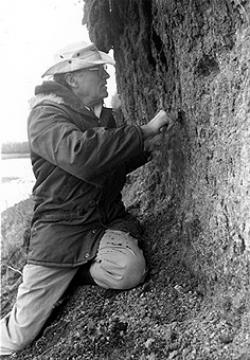Dr. Leigh Syms, Adviser for Historical Research
Dr. E. Leigh Syms has had a distinguished, active, and pioneering career in Canadian archaeology. He has contributed significantly through his accomplishments in academia, museology, cultural resource management, and relations with First Nations, and by his participation in the professional life of the discipline. The achievements of his career mark him as one of the important figures in Canadian archaeology, and he fully meets the criteria of the Smith-Wintemberg Award.
Leigh received his Ph.D. from the University of Alberta in 1976, although his active involvement in Canadian archaeology began a decade earlier. He continued as a faculty member at Brandon University, where he had taught since 1972, until taking the position of Curator of Archaeology at the Manitoba Museum of Man and Nature (now simply The Manitoba Museum). He has now retired from that position, but he remains active in the archaeological community. During the course of his career, he has made new and important contributions to Canadian archaeology in a number of ways. He developed the archaeology curriculum at Brandon University, he continues to be an Adjunct Professor in the Anthropology Department at the University of Manitoba, and he has advised or been a committee member of a dozen graduate theses/dissertations in the Anthropology, Geology and Icelandic Departments. He has produced at least 116 publications, of which 45 are basic research reports, 26 refereed and non-refereed articles, 7 book chapters, 17 popular articles on archaeology, and three published monographs. In both academic and museum contexts he has consistently won large and important research grants. At the Manitoba Museum, he has produced 16 exhibits, the last of which is the major Parklands/Mixed Woods Gallery. He has presented 36 professional conference presentations and made 83 public and non-professional presentations. His expertise has been sought as the reviewer of innumerable articles for the Canadian Journal of Archaeology and Plains Anthropologist, and he has been the referee of numerous SSHRCC applications and a National Science Foundation application. He has tirelessly worked as a proponent of the Canadian Heritage Inventory Network (CHIN) by working with a large group of Manitoba archaeologists to adapt and expand the capacity and relevance of this system to local archaeological needs.
Leigh has served the discipline in a number of administrative capacities. He has been a longstanding member of the Canadian Archaeological Association, the Plains Anthropological Association, and the Association of Manitoba Archaeologists. He has been President of each of these associations in addition to being Vice-President of the CAA and Director of the Board of Directors of the Plains Anthropological Association. He has served on the Historic Resources Advisory Board, the Manitoba Heritage Council, the legislation review committee that produced Manitobaís Heritage Resources Act (1984), and the Advisory Committee of the Forks Renewal Corporation. He has served the avocational archaeological community through his membership in both the Manitoba Archaeological Society and the Archaeological Society of Southwestern Manitoba and through his editorship of the latter organizationís publication Archae-Facts.
Leigh has made seminal contributions to Canadian archaeology in three areas. The first is his promotion of archaeology within, by and for the Aboriginal community. Leighís advocacy on this point has taken the form of training Aboriginal archaeologists through the Aboriginal Museum Internship Program and proactively cooperating with Aboriginal communities about their heritage needs and concerns, especially regarding repatriation of human remains and associated grave goods, stewardship of collections on behalf of Aboriginal communities, access to collections by members of the Aboriginal community, respect for the display and interpretation of Aboriginal objects, and creation of educational displays of Aboriginal materials for First Nations communities. The second major area of Leighís contribution is through public archaeology. He has established and run the Young Archaeologists Club, and, through it, given countless youth the opportunity to explore the wonderful world that archaeology represents. The third major contribution of Leighís is the redefinition of an archaeological report. Kayasochi Kikawenow, co-authored with Kevin Brownlee (himself a Cree person and a member of the Young Archaeologists Club and a graduate of the Aboriginal Museum Internship Program), reports on an eroded burial known as the Nagami Bay Woman. The book combines text, illustrations and data at a series of levels so that the book is relevant and interesting to both Aboriginal and non-Aboriginal readers at levels of interest and understanding from youth to professional. This is a new form of publication that addresses the often-lamented question of why there is so little interest in, funding for, and public and political support for archaeology. This book thus combines all three areas of Leighís innovative contributions. In a single volume, it presents archaeology to the broadest possible public audience at all levels of inquiry. It was written with an Aboriginal person and it incorporates extensive consultation with a specific Aboriginal community. Finally, it is one part of a reciprocal relationship between archaeologists and Aboriginal peoples that includes consultation, access, stewardship, education, and, most importantly, mutual respect. Such was that respect that the Chief and Council of the Nisichawayasick First Nation gave to Leigh and those who had worked directly with him that each member of the group was ceremonially given an eagle feather, an honour bestowed only once before on the community’s returning war veterans.

